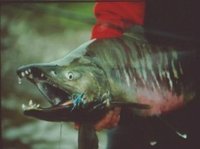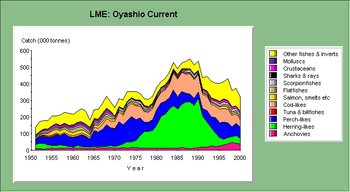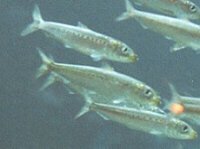Oyashio Current large marine ecosystem
Contents
Introduction Location of the Oyashio Current LME. (Source: NOAA (Oyashio Current large marine ecosystem) )
The Oyashio Current Large Marine Ecosystem (LME) is characterized by its sub-arctic climate. It is influenced by the cold Oyashio Current (“parent current”), also known as the Kurile Current. The Oyashio Current originates in the Sea of Okhotsk and flows south along the southern Kurile Islands. It meets the warmer Kuroshio Current off the coast of Japan’s Honshu Island. The topography of the LME includes the Kuril-Kamchatka Trench and Rise. The countries bordering the LME are Russia and Japan. LME book chapters and articles include Minoda, 1989[1].
Productivity
 (Source: NOAA)
(Source: NOAA) The LME has a narrow continental shelf. For a representation of the Oyashio Current and the warm water rings detached from the Kuroshio Current in the summer, see Minoda, 1989, p. 69. The confluence zone or front where the cold Oyashio Current meets the warm Kuroshio Current off northern Japan gives rise to some of the most productive areas of East Asia. The Oyashio Current LME is considered a Class I, highly productive (>300 gC/m2-yr) ecosystem based on SeaWiFS global primary productivity estimates. The Oyashio LME is known for its high biological productivity, with many species of fauna and flora (for instance the large-sized seaweed Laminaria). For more information on primary productivity in the spring and summer, see Taniguchi and Kawamura, 1972. Kawarada and Sano (1972) measured the chlorophyll concentration of phytoplankton along two sections of the current in 1969. Phytoplankton in this LME has "traditional" spring bloom dynamics (see Kasai et al. 1997) leading to a typical phytoplankton-macrozooplankton-fish food web. Odate (1986) estimates the zooplankton biomass at 1.1-3.7 x 106 tons. In Odate’s 25-year study, the zooplankton biomass was seen to increase between 1951 and 1976. It is believed that a high zooplankton biomass depends on the cold waters of the Oyashio Current below the thermocline. For more information on plankton, zooplankton, and oceanographic conditions in this LME, see Minoda, 1989. GLOBEC and JGOFS are conducting research in this LME. The GLOBEC project is studying fishing grounds located at the periphery of warm core rings.
Fish and Fisheries
 (Source: NOAA)
(Source: NOAA) Species harvested in this LME include the Japanese sardine, walleye pollock, tuna, squid, chub mackerel, skipjack, Pacific saury, anchovy, lantern fish, Pacific cod, flounder, rockfish, shrimp, and chum and pink salmon. Rich and productive fishing grounds are located at the confluence of the cold Oyashio Current and the warm Koroshio Current. Pelagic fish species migrating between the two currents take advantage of the different temperature ranges and phytoplankton blooms. For more information on fisheries (Fisheries and aquaculture), and catch fluctuations of pelagic fish, see Minoda, 1989. These fluctuations accompany changes in environmental conditions, such as the route taken by warm water masses. See Minoda, 1989, for a graph of the increase of the Japanese sardine catch between 1975 and 1984. Chub mackerel decreased in 1976 and disappeared as a fishery in Hokkaido by 1979. The salmon catch decreased in 1977 but has since stabilized. The recent increase in chum salmon is probably the result of Japanese efforts to breed salmon in hatcheries and then release them. The walleye pollock catch is subject to fluctuations. The observed decrease in bottom:dwellers such as shrimp and demersal fish is attributed to intensive exploitation. For a pie-chart of species composition in 1979 and 1984, see Minoda, 1989. Kelp and scallop are cultured. The University of British Columbia Fisheries Center has detailed fish catch statistics for this LME. A graphical representation of the data is provided below.
Pollution and Ecosystem Health
There are observed changes in the velocity and distribution of the Kuroshio and Oyashio currents. The LME is located at quite a distance from the coastal areas of Japan and Russia (Kamchatka). As a result, it is less affected by river and air pollution resulting from fast economic growth and industrial production. Marine resources are extensively exploited. Chum salmon fry released from hatcheries compete with other fish larvae for food. Shipping occurs through this LME, which connects the Sea of Okhotsk LME with the open Pacific Ocean. Oil pollution could become a significant problem along major shipping routes.
Socio-economic conditions
 (Source: NOAA)
(Source: NOAA) The countries bordering the LME are Japan (the Japanese island of Hokkaido), and Russia (the Kamchatka Peninsula). The LME is rich in natural resources, including minerals, fish, and potentially large oil and gas reserves. The economy of the region is mostly based on fisheries (Fisheries and aquaculture). Japan is a major fisheries nation. There are trading restrictions between Japan and Russia, based on the longstanding issue of sovereignty over the South Kurile Islands and the granting of fishing licenses by Russia to other countries. The population of the Kurile Islands is about 26,000. The islands have strategic and economic value, in terms of fisheries and also mineral deposits of pyrite, sulfur and various polymetallic ores.
Governance
The countries bordering the LME are Japan and Russia. There is a conflict between the two countries over the question of sovereignty over the Kurile Islands and fishing rights. The economic issue at stake is important because both nations face an economic crisis. Currently, Russia allows Japan only a small quota of fish, compared to the LME’s total potential harvest. Russia has also issued fishing licenses to countries such as South Korea, North Korea and Ukraine, whose fishermen all fish near the four disputed islands. Japan is seeking to prevent the implementation of a Russia-South Korea fishing agreement on the fishing of saury off the South Kurile shores. As Russia adjusts to its new economic situation, residents of the Kurile Islands might prefer to come under Japanese jurisdiction. Until 1993, the International North Pacific Fisheries Commission (INPFC), composed of Canada, Japan and the United States, was a regulatory agency for fisheries in the Oyashio Current LME. It has since been dissolved with the entry into force of the Convention for the Conservation of Anadromous Stocks in the North Pacific Ocean.
References
Articles and LME Volumes (Oyashio Current large marine ecosystem)
Other References
- Hata, K., 1969. Some problems relating to fluctuation of hydrographic conditions in the sea northeast of Japan. Part I. Relation between the patterns of the Kuroshio and the Oyashio. J. Oceanogr. Soc. Japan 25:25-35.
- Hayashi, K. 1984. Present resource situation and biological characteristics of walleye pollock around Hokkaido. Bull. Japanese Soc. Fish. Oceanogr. 60-64. (in Japanese)
- Karohji, K. 1972. Regional distribution of phytoplankton in the Bering Sea and western and northern subarctic regions of the North Pacific Ocean in summer. In Biological Oceanography of the Northern Pacific Ocean. 99-115. Ed. By Takenouti et al. Idemitsu Shoten, Tokyo.
- Kasai, H., Saito, H., Yoshimori, A., and T. Taguchi, 1997. Variability in timing and magnitude of spring bloom in the Oyashio region, the western subarctic Pacific off Hokkaido, Japan. Fish. Oceano., 6:118-129.
- Kawarada, Y. and Sano, A. 1972. Distribution of chlorophyll a and phaeopigments in the northwestern North Pacific in relation to the hydrographic conditions. In Biological Oceanography of the Northern Pacific Ocean. 125-138. Ed. By Takenouti et al. Idemitsu Shoten, Tokyo.
- Motoda, S., and Marumo, R., 1963. Plankton of the Kuroshio water. Proc. Sym. Kuroshio p 40-61.
- Noto, M. and I. Yasuda, 1999. Fluctuation in the Japanese sardine population with relation to the sea surface temperature in the Kuroshio Extension, in Ecosystem Dynamics of the Kuroshio-Oyashio Transition Region. Proc. International Marine Science Symposium. Published by Japan Marine Science Foundation, 166-178.
- Ohtani, K., Akiba, Y., Yoshida, K., and Ohtsuki, T. 1971. Studies on the change of the hydrographic conditions in the Funka Bay. Part III. Oceanographic conditions of the Funka Bay occupied by the Oyashio waters. Bull. Fac. Fish. Hokkaido Univ. 22:129-142. (In Japanese).
- Shiomoto, A., Katsuyuki Sasaki, Toru Shimoda and Satsuki Matsumura, 1994. Primary Productivity in the Offshore Oyashio in the Spring and Summer 1990. Journal of Oceanography, Vol. 50 (No. 2), pp. 209-222.
- Shiomoto, A. 2000. Chlorophyll-a and primary production during spring in the oceanic region of the Oyashio Water, the north-western Pacific. Journal of the Marine Biological Association of the United Kingdom. Vol. 80 No. 2, 343.
- Taniguchi, A., and Kawamura, T. 1972. Primary production in the Oyashio region with special reference to the subsurface chlorophyll maximum layer and phytoplankton-zooplankton relationships. In Biological Oceanography of the Northern Pacific Ocean. 232-243. Ed. By Takenouti et al. Idemitsu Shoten, Tokyo.
- Taylor, F.J.R., and Waters, R.E. 1982. Spring phytoplankton in the subarctic North Pacific Ocean. Mar. Biol., 67:323-335.
- Yasuda, I., K. Okuda and Y. Shimizu, 1996. Distribution and modification of the North Pacific Intermediate Water in the Kuroshio-Oyashio Interfrontal zone. J. Phys. Oceanogr., 26:448-465.
- Yasuda, I. and Y. Watanabe, 1994. On the relationship between the Oyashio front and saury fishing grounds in the north-western Pacific. Fish. Oceanogr., 3:172-181.
- Yoshinari, H. and I. Yasuda, 1999. Characteristics of North Pacific Intermediate Water in the Kuroshio-Oyashio interfrontal zone, in Ecosystem Dynamics of the Kuroshio-Oyashio Transition Region. Proc. International Marine Science Symposium Published by Japan Marine Science Foundation, 44-53.
| Disclaimer: This article is taken wholly from, or contains information that was originally published by, the National Oceanic and Atmospheric Administration (NOAA). Topic editors and authors for the Encyclopedia of Earth may have edited its content or added new information. The use of information from the National Oceanic and Atmospheric Administration (NOAA) should not be construed as support for or endorsement by that organization for any new information added by EoE personnel, or for any editing of the original content. |